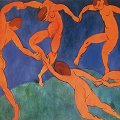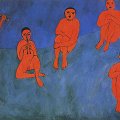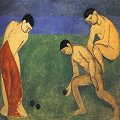From Russia with Love
The Music and the Dance
Shchukin and the Commissioning of La Danse and La Musique
 In the years 1909-10 a serious blow to morale led Matisse to the brink
of despair. The crisis stemmed from the unfortunate convergence of two
events. The first concerned a commission from Sergei Shchukin,
a rich Russian importer of oriental fabrics who asked Matisse for two
large paintings for the grand staircase of his palatial residence in
Moscow. The second incident involved harsh criticism of the works Matisse
exhibited at the Salon d'automne in 1910.
In the years 1909-10 a serious blow to morale led Matisse to the brink
of despair. The crisis stemmed from the unfortunate convergence of two
events. The first concerned a commission from Sergei Shchukin,
a rich Russian importer of oriental fabrics who asked Matisse for two
large paintings for the grand staircase of his palatial residence in
Moscow. The second incident involved harsh criticism of the works Matisse
exhibited at the Salon d'automne in 1910.
The Matisse archives contain an initial letter from Shchukin dated February 21, 1909, followed by four others between March 16 and 31 of that same year. In these letters, Shchukin commissioned Matisse to paint La Danse (Dance) and La Musique (Music), constituting Matisse's first approach to an architectural setting. One early point of discord concerned the nudity of the figures in the paintings. The Russian patron shared his mansion with two nieces, so after having received early sketches of La Danse he wrote to Matisse: "I cannot at this time place nudes in my staircase... Manage to show the same round dance, but with girls in dresses". Eleven days later, Shchukin made a different proposition: he would take another painting of La Danse smaller in size, for the same price (15,000 francs). This painting could remain in a private zone, so to speak, rather than hang in the public part of the house. The new commission did not cancel the earlier agreement concerning two paintings for the staircase, where Shchukin wanted to "avoid nudes".
Yet on receiving a missive from Matisse, Shchukin telegraphed him the following day, March 28: "The water-color sketch of La Danse overcomes all reservations expressed in my letters". Three days later, he confirmed in a letter: "...your panel of La Danse is so noble that I have decided to fly in the face of bourgeois opinion and place a subject with 'nudes' over my staircase... You now have my firm commission for the two panels".
La Musique would nevertheless be "retouched", as later events revealed. The Shchukin collection was confiscated and nationalized by the Soviet government. Although considered national treasures, Matisse's works were effectively banned; they remained inaccessible and unknown to the public until 1969, when an official show was held first in Moscow and then in Leningrad (now St. Petersburg). The panel depicting La Musique was indeed exhibited, but in a censored version. Matisse had mentioned this censorship to his Moscow friend, Alexander Romm, back in October 1934, when he wrote: "Let me just say that, in the panel of La Musique, the owner had a little red paint added to the second figure, a little flute player with crossed legs. Some red was added to hide his penis, even though it was handled very discreetly, and was done to complete the torso. A restorer would need just a little solvent, like the mineral spirit benzene, and rub that spot for a moment so that the masked lines reappear". Fortunately, this restoration was subsequently carried out.
 To return to the year 1910, Matisse was actively preparing Shchukin's
two panels, which would first be exhibited at the Salon d'automne, held in
Paris at the Grand Palais on the Champs-Elysees from October 1 to November
8 of that year. He worked alternately on both, going from one panel to
another in order to maintain his bearings in terms of "the complete
agreement of colors", as he wrote to Shchukin. The patron, meanwhile, sent
two letters to Matisse. The first, dated May 30, 1910, reported that
"people laugh at me a little, but I always reply, 'He who laughs last,
laughs best.' I still have faith in you". The second, dated August 20,
confirmed that Shchukin was still "greatly interested in the
decorations... I'm sure they will be a triumph. I hope to be in Paris for
the Salon d'automne".
To return to the year 1910, Matisse was actively preparing Shchukin's
two panels, which would first be exhibited at the Salon d'automne, held in
Paris at the Grand Palais on the Champs-Elysees from October 1 to November
8 of that year. He worked alternately on both, going from one panel to
another in order to maintain his bearings in terms of "the complete
agreement of colors", as he wrote to Shchukin. The patron, meanwhile, sent
two letters to Matisse. The first, dated May 30, 1910, reported that
"people laugh at me a little, but I always reply, 'He who laughs last,
laughs best.' I still have faith in you". The second, dated August 20,
confirmed that Shchukin was still "greatly interested in the
decorations... I'm sure they will be a triumph. I hope to be in Paris for
the Salon d'automne".
But the criticism leveled at the work on this occasion-according to several letters and press reports on the Salon, the latter mentioning only La Danse was all the nastier for being devoid of technical or aesthetic analysis. Matisse was being sentenced without being judged. The art critic for Gil Blas, Leopold Rude, outdid himself by suggesting that "mental illness" might provide an excuse. "I find no epithet more appropriate to describe this poor Monsieur Henri Matisse who could reasonably be expected to make an impact only on hysterical Finnish women or completely cracked Norwegians. Like everyone else, I'm fully aware that this master of unbalanced painting has opened a studio that attracts Nordic students, that he is fashionable, and that he exploits many madmen to his great profit. But how sad and regrettable to see the rantings of this gentleman displayed in the main hall of an official exhibition space in the heart of Paris... It is truly excessive... all mental asylums have similar paintings where, upon my word, mental illness is an excuse... This is just too awful. Enough said".
Shchukin, meanwhile, was eager to have a look at the decorative art planned for his home. He traveled to Paris and headed straight to the Grand Palais, where he saw the panels. He uttered not a word. He had not only seen the paintings, he had also read the reviews. Had it been a question of objective criticism and analysis, he might have kept a cool head. But the flood of insults deeply affected him.
Destabilized, he decided to cancel the commission.
It is hard to imagine the seriousness of this blow to the artist. It must have been one of the most terrible moments in his life (along with the 1944 arrest of his wife and daughter for resistance to the Nazi regime). Since Shchukin was in Paris, he must have canceled the commission in person. Matisse was then forty years old; fifteen or twenty years of mental and financial struggle up to this point made this disappointment particularly bitter, not to mention that it dashed his hopes for the future as well. The wound went all the deeper for being delivered by a major backer who had previously demonstrated faith in him.
Shchukin returned to Moscow. The journey lasted two days and two nights. As soon as he reached Moscow on November 10, 1910, he cabled Matisse: "Reflected during trip. Decided to take panels. Please send Danse and Musique with all speed. Regards".
The next day, Shchukin wrote a letter confirming the new decision announced in his telegram. "I've thought things over and I'm ashamed of my weakness and lack of courage. One should never flee the battlefield without putting up a fight. For that reason I have decided to hang your panels. People may shout and laugh, but since I'm convinced that your path is the right one, perhaps time will be my ally and I shall claim victory in the end".
The panels arrived in Moscow on December 17, 1910.
Henri Matisse Art

|
|
More
Articles
 Art Encyclopedia A world history of art in articles.
Art Encyclopedia A world history of art in articles.
Modernism
Henri Matisse
Life and work.
The Music. The Dance.
Simply painting and color.
Paper cutouts.
Art
 Art Wallpapers Art image collections for your desktop.
Art Wallpapers Art image collections for your desktop.
Munch Art, $19
(75 pictures)
Malevich Art, $25
(105 pictures)
Modigliani Art, $29
(135 pictures)
Klee Art, $25
(150 pictures)
Miro Art, $35
(150 pictures)
Matisse Art, $29
(180 pictures)
Picasso Art, $29
(175 pictures)
Dali Art, $35
(275 pictures)
Chagall Art, $35
(175 pictures)

